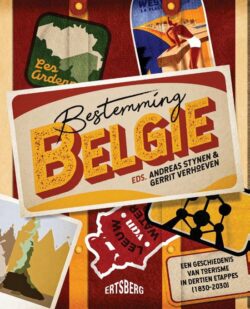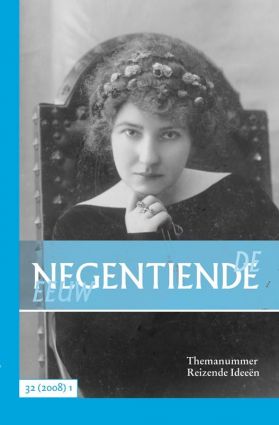Antwerpen: Ertsberg 2022, 272 p.
ISBN 9789464369502
€27,50
Urban explorers of Urbex’ers zullen na lectuur van Bestemming België ongetwijfeld nog enkele namen kunnen toevoegen aan hun lijstje van vervallen, nostalgie wekkende toeristische plaatsen. De bedoeling van deze bundel is om aan de hand van beschrijvingen van vergeten toeristische plekken een aanzet te geven tot een panoramisch overzicht van het toerisme in België in de negentiende en vroege twintigste eeuw, een periode waarin het zich bijzonder snel heeft ontwikkeld. Het boek is breed opgevat en gaat zowel over het hotel Kosmos op de Rodeberg en de vakantiekolonies aan de kust als over de Wereldtentoonstelling in Antwerpen in 1894 en over koloniaal toerisme in Belgisch-Congo. Bovendien biedt het een geschiedenis van het toerisme van 1830 tot-2030 in dertien hoofdstukken, die evenwichtig over de hele periode zijn verdeeld. Elk hoofdstuk focust op een eigen bestemming waarvan de individuele ontwikkelingsdynamiek wordt beschreven. Interessant is dat er heel verschillende vormen van toerisme aan bod komen: niet alleen reizen tot lering en vermaak, maar ook oorlogstoerisme naar Waterloo of de slagvelden rond Ieper, religieus toerisme naar Banneu en gezondheidsvakanties aan de kust.
De inleiding van de redacteurs geeft een beknopt overzicht van de toeristische ontwikkelingen, de impact van reisfaciliteiten zoals de snelle ontsluiting van het spoor in België en van de sociale verschuivingen in het toerismepubliek. Trok de kust, in het bijzonder Oostende, tijdens de belle époque een welgestelde en internationale klasse kustgangers aan, na de invoering van de Wet op de Zondagsrust (1905) en vooral van de ‘congé payé’ in 1936 begonnen de lagere klassen de Belgische badplaatsen te overspoelen. De welvaartsstijging in de jaren vijftig en zesde zorgde voor een nog snellere democratisering van het toeristisch publiek, waardoor exclusieve hotels leegliepen en plaats maakten voor betaalbare pensions, gezinscampings en -homes en vakantieparken. Het is de aandacht voor ook dit toeristisch erfgoed, de vakantiekolonies, attractieparken en campinggebouwen, kortom voor de historische diversiteit van het toerisme, die van Bestemming België boeiende lectuur maken.
Het boek vormt ook een geslaagd geheel doordat er onnadrukkelijk verschillende rode draden door de bijdragen heen te ontdekken zijn, die in de inleiding worden aangekondigd. Een eerste is de aandacht voor de actoren in de toerismesector. Dit zijn zowel nationale en stedelijke besturen, handelaars, lokale groepen van burgers, maar ook de toeristen zelf die een herdenkingspraktijk mee vormgeven. Met de toename van het toerisme nam ook de nood aan planning en voorbereiding toe. Daarbij hielpen niet alleen reisgidsen maar ook reisorganisatoren, zoals de reeds van 1895 daterende Touring Club en de in Vlaanderen alom bekende VTB, opgericht in 1922, waaraan een volledig hoofdstuk wordt gewijd.
Ten tweede worden de motieven om te reizen als een leidraad door het boek heen geweven. Ook de onderliggende belangen, de politieke en ideologische intenties achter de toeristische uitbouw zou je hier aan toe kunnen voegen. Dat wordt bijvoorbeeld in het hoofdstuk ‘Toerisme in de kunststeden’ mooi geïllustreerd. Het instandhouden van het oude Brugge diende niet alleen als attractie voor het middelklastoerisme, maar de wens om de stad in haar oude, gotische glorie te herstellen sloot ook goed aan bij de traditionele conservatieve lijn van de katholieke partij, die lange tijd de burgemeesterssjerp van Brugge mocht claimen. De rol van nationale mythevorming annex de verkoop van relieken en de verspreiding van bizarre anekdotes, wordt aan de hand van de herdenkingsgeschiedenis rond de Slag van Waterloo toegelicht. De reisgidsen voor Belgisch-Congo en de promotie van Sabena in de jaren vijftig illustreren dan weer een onderliggende agenda bij het koloniaal toerisme in Stanleyville, nu Kinsangani: hier ging het voornamelijk om pro-imperialistische propaganda die het koloniaal beleid moest legitimeren. Ook het hoofdstuk over de Oostkantons is een mooi voorbeeld van politieke instrumentalisering. Het toerisme moest ook de ‘ontduitsing’ en de creatie van een een regiogevoel met België helpen stimuleren.
De redacteurs zien ten derde ook spanningslijnen in het boek als rode draad: die van de sociale diversiteit, met enerzijds het elitaire toerisme in Knokke en Oostende en anderzijds de opkomst van volkse badplaatsen, ook in het binnenland. Het hoofdstuk ‘Hofstade-plage’ beschrijft de ontwikkeling van deze ‘volksplage’ of ‘rommelzoo’, bijzonder populair bij de minder gegoede dagjestoeristen, maar een doorn in het oog van de Katholieke Actie die zich grote zorgen maakte over de zedenverwildering. En daar botste het ook tussen de verdedigers van cafés in Oud-Belgiëstijl, afdankertjes van de Wereldtentoonstelling van Antwerpen, en moderne ontwerpen van Victor Bourgeois en Andre Wynants, die het sociaal toerisme een degelijke infrastructuur én een moderne architectuur wilden bieden.
De spanning tussen de culturele meerwaardezoeker en de massatoerist, de dreigingen van het economische groeimodel en de ecologisch impact hiervan, de explosieve toename van stadstoerisme met alle problemen van dien, de banale architectuur van vakantiewoningen, de worsteling met het grootschalige toerisme, het wordt na lectuur van dit boek duidelijk dat dit niet alleen problemen van vandaag zijn. Al aan de vooravond van de Eerste Wereldoorlog was er hevig verzet van de plaatselijke bevolking tegen de impact van toerisme op de Ardennen.
Een toekomstbeeld, aangekondigd met het jaartal 2030 op het kaft, komt aan bod in het laatste hoofdstuk. Met de coronacrisis leken even mogelijkheden in zicht om het overtoerisme te counteren. Hoewel Jan Van der Borg optimistisch besluit dat Toerisme Vlaanderen de basis heeft gelegd voor een nieuw toeristisch verdienmodel, zijn de ontwikkelingen niet erg hoopgevend. Van belangwekkende bezinningsmomenten in de toeristische sector of van enige wending naar duurzamer toerisme is er in 2024 weinig te merken.
Er valt veel te ontdekken in deze bundel. De bronnen zijn al even veelzijdig als de bijdragen: vanzelfsprekend komen reisgidsen aan bod, promotiemateriaal en affiches, maar ook sporen die bezoekers achterlieten, verhaaltradities die al snel na de gebeurtenissen ontstonden en – zoals in de bijdragen over de campings van Bredene en het koloniaal toerisme in Belgisch-Congo – ook interviews met betrokkenen. Bestemming België doet wat het belooft: de toegankelijke, goed gestoffeerde hoofdstukken mét illustraties bieden een aantrekkelijk overzicht van twee eeuwen toerisme in België.





